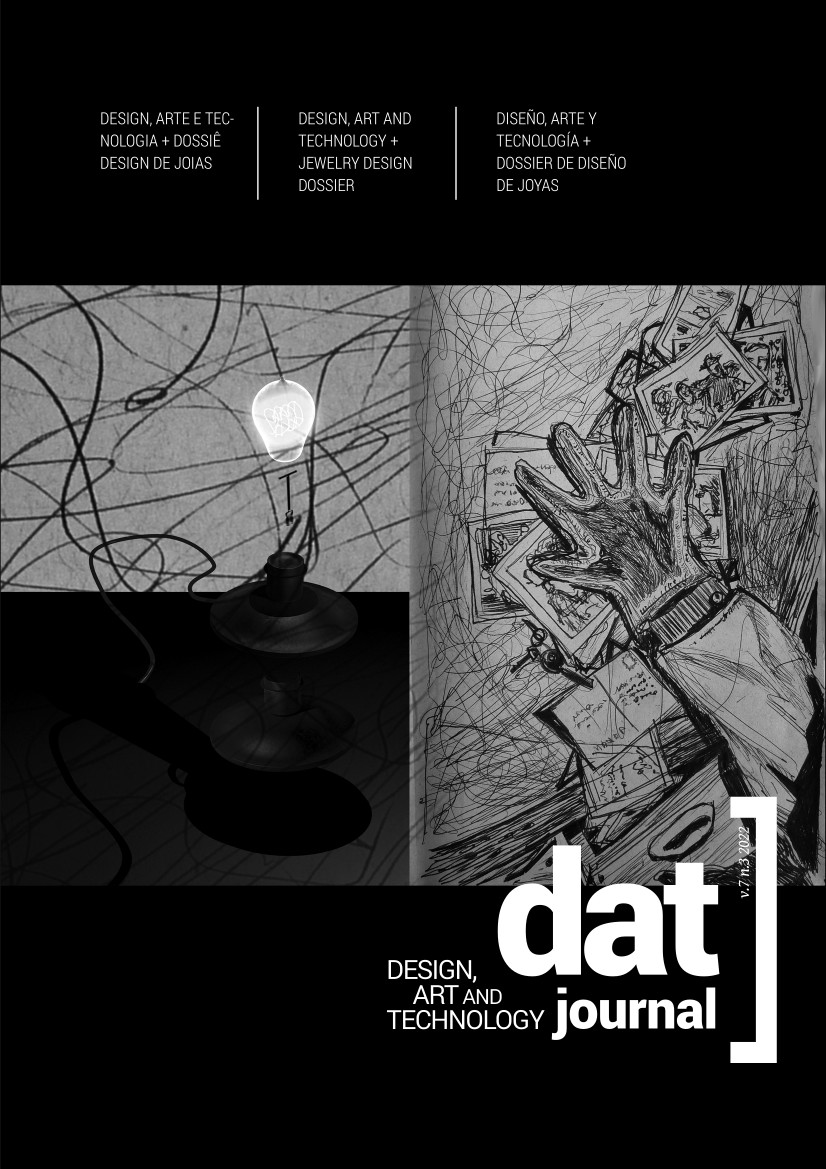Avaliação de protetores faciais para controle da transmissão de COVID-19: um estudo de caso em São Luís – MA
DOI:
https://doi.org/10.29147/datjournal.v7i3.656Palavras-chave:
Design, COVID-19, Satisfação de uso, PercepçãoResumo
Foram avaliados 03 (três) modelos de protetores faciais, por 08 (oito) profissionais de saúde, com atuação em atendimento a pacientes com suspeita ou confirmação de diagnóstico de COVID - 19. Os protetores foram avaliados durante uma semana e ao término de cada semana, os voluntários responderam aos formulários de pesquisa e enviaram registros. Os resultados apontaram para recomendações que podem contribuir para a definição de requisitos de design que auxiliem no desenvolvimento de artefatos que atendam às percepções e expectativas dos profissionais de saúde.
Downloads
Referências
ABERGO. Norma ERG BR 1002 - Código de Deontologia do Ergonomista Certificado. Asso¬ciação Brasileira de Ergonomia, 2003.
BANGOR, A., KORTUM, P., MILLER, J. Determining what individual sus scoresmean: Adding an adjective rating scalejus. JUS - The Journal of Usability Studies ,4(3):113–123 p, 2009.
BRASIL. Agência Nacional de Vigilância Sanitária (ANVISA). Nota técnica GVIMS/GGTES/ ANVISA Nº 04/2020. Orientações para serviços de saúde: Medidas de prevenção e controle que devem ser adotadas durante a assistência aos casos suspeitos ou confirmados de in¬fecção pelo novo CORONAVÌRUS( SARS- CoV-2). Diário Oficial da União, Poder Executivo, Brasília, DF, 30 de jan. 2020a. Disponível em: https://www.gov.br/anvisa/pt-br/centrais¬deconteudo/publicacoes/servicosdesaude/notas-tecnicas/nota-tecnica-gvims_ggtes_anvi¬sa-04_2020-25-02-para-o-site.pdf . Acesso em: 22 de julho de 2021.
BRASIL. Agência Nacional de Vigilância Sanitária (ANVISA). RESOLUÇÃO- RDC Nº 356, DE 23 DE MARÇO DE 2020. Diário Oficial da União, Poder Executivo, Brasília, DF, 23 de mar. 2020b. Disponível em: https://legislacao.presidencia.gov.br/atos/?tipo=RES&nume-ro=356&ano=2020&ato=a69QzYE5EMZpWT389 . Acesso em: 22 de julho de 2021.
DAHLGAARD, J. J. et al. Kansei/affective engineering design: A methodology for profound affection and attractive quality creation. The TQM Journal, v. 20, n. 4, p.299–311, 2008. ISSN 1754-2731. Disponível em: http://www.emeraldinsight.com/101108/17542730810881294 Acesso em: 17 de agosto 2021. DOI: https://doi.org/10.1108/17542730810881294
HOLDEN, R. J. A Simplified System Usability Scale (SUS) for Cognitively Impaired and Older Adults. Proceedings of the International Symposium on Human Factors and Ergonomi¬cs in Health Care, v. 9, n. 1, 2020, p. 180–182. DOI: https://doi.org/10.1177/2327857920091021
HUANG, Y.; CHEN, C-H.; KHOO, L. P. Kansei clustering for emotional design using a combined design structure matrix. International Journal of Industrial Ergonomics, v. 42, pp. 416- 427, 2012. DOI: https://doi.org/10.1016/j.ergon.2012.05.003
KHAN, M.M., PARAB, S.R. Safety Guidelines for Sterility of Face Shields During COVID 19 Pandemic. Indian J Otolaryngol Head Neck Surg, v. 73, p. 85–86, 2021. DOI: https://doi.org/10.1007/s12070-020-01865-2
KRIPPENDORFF, K. On the essential contexts of artifacts or on the proposition that ‘design is making sense (of things)’. In: MARGOLIN, V.; BUCHANAN, R. The Idea of Design. 2ª. ed. Cambridge: MIT Press, 1995. p. 156-184.
LANUTTI, J. N. DE L; FERNANDES, F. R. CAMPOS, L. F. A.; PASCHORELLI, L. C. Usabilidade de objetos de uso cotidiano: comparativo de técnicas de avaliação subjetiva (SUS E DS). Anais do 13º Congresso Internacional de Ergonomia e Usabilidade de Interfaces Humano¬-Tecnologia: produto, informação, ambiente construído e transporte. Juiz de fora, MG: UFJF, 2013.
LEWIS, J.R. BROWN, J.; MAYES, D.K. Psychometric evaluation of EMO and SUS in the context of an unmoderated large-sample usability study. International Journal of Human-Compu¬ter Interaction, 31 (8), 545–553. DOI: https://doi.org/10.1080/10447318.2015.1064665
NAGAMACHI, M. Kansei Engineering as an ergonomic consumer-oriented technology for product development. Applied Ergonomics, 33,289-294, 2002. DOI: https://doi.org/10.1016/S0003-6870(02)00019-4
OSGOOD, C. E.; SUCI, G. J.; TANNENBAUM, P. H. The Measurement of Meaning. Urbana: University of Illinois Press, 1967. 346 p. ISBN 0-252-74539-6.
PRAKASH, G et al. Compliance and Perception About Personal Protective Equipment Among Health Care Workers Involved in the Surgery of COVID-19 Negative Cancer Patients During the Pandemic. J Surg Oncol. volume 122, issue 6, P1013-1019 2020. DOI: https://doi.org/10.1002/jso.26151
RAZZA, B. M.; PASCHOARELLI, L. C. O Sistema Kansei de Engenharia como um método de design industrial. Sodebras, v. 13, p. 67-72, 2018.
ROBERGE. R. J. Face shields for infection control: A review. J Occup Environ Hyg. v. 13(4), 2016, p. 235-242. DOI: https://doi.org/10.1080/15459624.2015.1095302
SANTOS, A. dos. Seleção do método de pesquisa: guia para pós-graduando em design e áreas afins. Curitiba, PR: Insight, 2018. 230 p.
SAURO, J. LEWIS, J.R. Quantifying the User Experience: Practical Statistics for User Re¬search. Morgan Kaufmann: Waltham, 2012. 313p. DOI: https://doi.org/10.1016/B978-0-12-384968-7.00002-3
SES. Secretaria do Estado de Saúde. Governo do Maranhão. Boletins COVID-19.Av. Professor Carlos Cunha, S/N, Jaracaty, São Luís, MA. Disponível em:< https://www.saude.ma.gov.br/boletins-covid-19/> Acessado em 26 de agosto de 2021.
SEVILLA-GONZALEZ MDR, MORENO LOAEZA L, LAZARO-CARRERA LS, BOURGUET RAMIREZ B, VÁZQUEZ RODRÍGUEZ A, PERALTA-PEDRERO ML, ALMEDA-VALDES P. Spanish Version of the System Usability Scale for the Assessment of Electronic Tools: Development and Valida¬tion. JMIR Hum Factors v.7, n.4:e21161, 2020, p. 1-7. DOI: https://doi.org/10.2196/21161
SIEGEL, J.D; RHINEHART, E.; JACKSON, M.; CHIARELLO, L.; HEALTHCARE INFECTION CON¬TROL PRACTICES ADVISORY COMMITTEE. Guideline for Isolation Precautions: Preventing Transmission of Infectious Agents in Healthcare Settings, 2007. Disponível em: https://www.cdc.gov/infectioncontrol/guidelines/isolation/index.html . Acessado em 26 abr 2022.
STOKLASA, J., TALÁŠEK, T. STOKLASOVÁ, J. Semantic differential for the twenty-first cen¬tury: scale relevance and uncertainty entering the semantic space. Quality & Quantity, v. 53, 2019, p. 435–448. DOI: https://doi.org/10.1007/s11135-018-0762-1
TULLIS, T.; ALBERT, W. Measuring the user experience: collecting, analyzing, and presen¬ting usability metrics. Newnes, 2013.
ULLAH, F; SEPASGOZAR, S. M. E; THAHEEM, M. J; WANG, C.C; IMRAN, M. It’s all about percep¬tions: A DEMATEL approach to exploring user perceptions of real estate online platforms. Ain Shams Engineering Journal, v. 12, n. 4, p. 4297-4317, 2021. DOI: https://doi.org/10.1016/j.asej.2021.04.023
WHO. WORLD HEALTH ORGANIZATION. Requirements and technical specifications of per¬sonal protective equipment (PPE) for the novel coronavirus (2019-ncov) in healthcare settings. Geneva, 2020. Acessado em 30/03/2019. https://www.google.com/url?sa=t&rct=j&¬q=&esrc=s&source=web&cd=3&ved=2ahUKEwjS2di4-q3oAhVXh1wKHWeGDvEQFjACegQIA-RAB&url=https%3A%2F%2Fwww.paho.org%2Fen%2Ffile%2F59297%2Fdownload%3Ftoken%-3Dbr2NtqhR&usg=AOvVaw1Sicp3C6m3fjFm
Downloads
Publicado
Como Citar
Edição
Seção
Licença

Este trabalho está licenciado sob uma licença Creative Commons Attribution 4.0 International License.


























